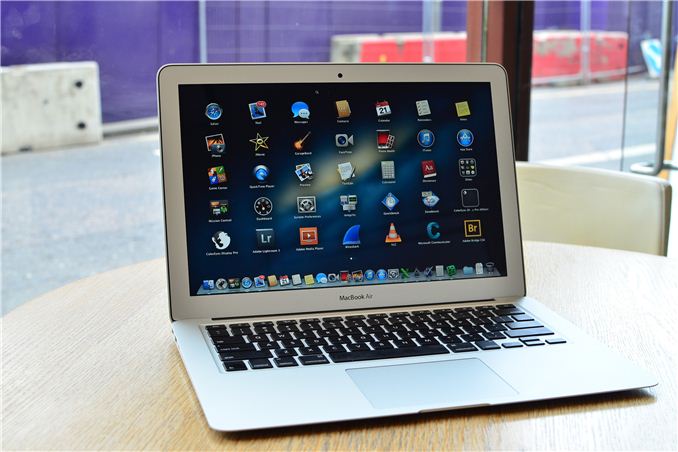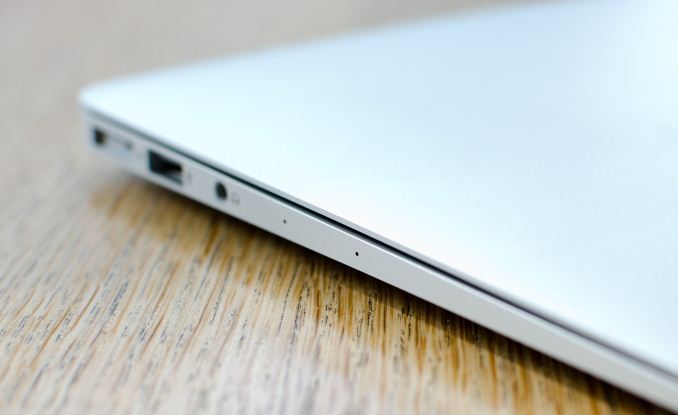The 2013 MacBook Air Review (13-inch)
by Anand Lal Shimpi on June 24, 2013 12:01 AM EST
Things didn’t go exactly as I’d expected at WWDC. I spent the week before the show at Computex, talking to PC OEMs, who had all just launched their Haswell ULT based Ultrabooks. With a couple of exceptions however, the bulk of Haswell ULT systems weren’t scheduled to ship until later this year. Even the Acer S7 I snagged while in Taipei was still a pre-production unit, with final hardware due out in the next month. Based on what I saw in Taiwan, and Intel having seeded me an Iris Pro machine the week before, I assumed that the MacBook Pro with Retina Display is what would get the Haswell treatment first. Obviously, that didn’t happen.
In hindsight, the move makes sense. Apple will sell far more MacBook Airs than rMBPs. The Apple/Intel relationship is looking very healthy these days, so it’s also not surprising that it would have supply and early enough access to Haswell ULT to launch the MBAs at WWDC with almost immediate availability. The Haswell ULT shift didn’t require a new chassis for Apple, which meant a less complex development process.
From the outside, the new MacBook Air looks nearly identical to its predecessor. There's a second mic opening on the left side of the machine now, but otherwise you'd be hard pressed to tell this year's model apart from the previous generation. Internally, nearly everything has changed.
The battery is higher capacity, with no increase in weight. Making better use of that larger battery is Intel's new Haswell ULT silicon. Since we're talking about a ULT part, the PCH moves from the motherboard to the CPU package - creating an emptier motherboard than we've seen in previous years:
The 2013 13-inch MacBook Air Motherboard, Courtesy iFixit
It's clear to me that the MBA is due for a more significant redesign, but this is not the year for that.
Alongside Haswell comes a brand new PCIe SSD, 802.11ac support and LPDDR3 memory. All at a price equal to, if not less than last year's models:
| 2013 MacBook Air Lineup | ||||||
| 11.6-inch | 11.6-inch (high-end) | 13.3-inch | 13.3-inch (high-end) | |||
| Dimensions |
H: 0.11-0.68" (0.3-1.7cm)
W: 11.8" (30cm) D: 7.56" (19.2cm) |
H: 0.11-0.68" (0.3-1.7cm)
W: 12.8" (32.5cm) D: 8.94" (22.7cm) |
||||
| Weight | 2.38 lbs (1.08kg) | 2.96 lbs (1.35kg) | ||||
| CPU | 1.3GHz dual-core Core i5 | 1.3GHz dual-core Core i5 | ||||
| GPU | Intel HD 5000 | |||||
| RAM | 4GB LPDDR3-1600 | |||||
| SSD | 128GB PCIe SSD | 256GB PCIe SSD | 128GB PCIe SSD | 256GB PCIe SSD | ||
| Display Resolution | 1366 x 768 | 1440 x 900 | ||||
| Ports | Thunderbolt, 2x USB 3.0, headphone jack | Thunderbolt, 2x USB 3.0, SD card slot, headphone jack | ||||
| Networking | 2x2:2 802.11ac | 2x2:2 802.11ac | ||||
| Battery | 38 Wh | 54 Wh | ||||
| Price | $999 | $1199 | $1099 | $1299 | ||
We've been over the MacBook Air chassis thoroughly in the past so I won't go through it again here. Build quality remains excellent. The clickpad and backlit keyboard never give me any troubles either. It's sad that we're still having clickpad issues elsewhere in ultraportables but this is one area where Apple's vertically integrated advantage is apparent (as is the company's willingness to spend a little extra on even the little details).
The only thing that hasn't changed, that perhaps should have is the display. The MacBook Air retains the same 1366 x 768/1440 x 900 panels from last year, while much of the competition has moved to at least 1080p IPS in the 13.3-inch form factor. This year at Computex we saw a number of systems move to 2560 x 1440 13.3-inch panels, at least as an option, however I'm expecting those systems to be priced more in line with the 13-inch rMBP rather than the MacBook Air. Admittedly, I don't know the right solution here.Ultra high resolution panels drive cost and power consumption up, the latter which can be offset by going to a larger battery - but then you have a 13-inch rMBP. Perhaps the right move for the MacBook Air would be for Apple to move to IPS panels at least? Or maybe we see a merger of the 13-inch MBA/rMBP, and something new entirely replace the 11-inch model.












233 Comments
View All Comments
arkhamasylum87 - Monday, June 24, 2013 - link
Broadwell will have a refreshed GPU architecture and with the process shrinks, the gains would be more amenable to all. Although the intent to raise the GPU perf a decent percentage with dedicating more than the half the die is a big time change at Intel.rmr - Monday, June 24, 2013 - link
Hi Anand,Good review! I'm waiting for the updated review (using the i7 processor). BTW will it be possible for you to test the Air with an older 802.11g router (since some people have been complaining in the Apple forums about the Air dropping Wifi connections)? I was planning to get a new MBA but I'll be mostly using it at locations with older .11g routers.
Thanks.
Regards,
rmr
scyap - Monday, June 24, 2013 - link
Did the writer mention what OSX version was used for testing? Or I missed out?If this review was using Mountain Lion, should I expect even better battery life in Mavericks?
xype - Tuesday, June 25, 2013 - link
Yes, you should. Every dev I know who runs on Mavericks reports 10-20% better battery life (that's mighty subjective and unscientific, but I am sure AnandTech will do a proper test).Personally I'll make use of my dev account and upgrade as soon as all the dev tools I need are confirmed a running (homebrew-installed stuff mostly).
Ricopolo - Tuesday, June 25, 2013 - link
Anand, love your site. But your constant use of acronyms (like PCH, TDP, etc) that are non-household terms can be quite an obstacle to lay people, who are interested in gaining a bit of insight in tech development. Can you put together a glossary for these acronyms and put it in the footer or somewhere obvious?Thanks a lot.
SkylerSaleh - Tuesday, June 25, 2013 - link
PCH stands for Platform Controller Hub. It provides some needed utilities required to run the CPU correctly, such as display handling, connecting peripherals, DMI, etc. As a lay-mans example, the PCH supports the CPU's operation, similar to how your subconscious supports your operation. Taking over the responsibility of semi-voluntary/non-voluntary actions like breathing, so that you can think about other things.TDP stands for thermal design power. It is a measurement of the maximum amount of cooling that is needed to cool a chip in its worst case. As a rule of thumb, the higher the TDP, the more power the chip will use at peak. (However this is not a good measurement of power usage when idle.)
name99 - Tuesday, June 25, 2013 - link
Google shows up the obviously correct results for both of these very high in its list.If you want even cleaner and simpler results search on wikipedia.
I don't want to be a dick, but part of Anand being a fairly high-end site (including, for example, the variety of technical details which make it substantially more interesting than a Macworld or The Verge or WSJ review) is that it consists of an engineering aware community, which speaks in its natural language, just like any other community.
If you wish to be part of that community, the solution is not to complain that they use unfamiliar language, but to familiarize yourself with that language. It's not hard --- more so than ever before in the past you can learn what you need to just by scanning Google and wikipedia. And if you want to understand more details, again it's easier than its ever been before --- just look over the review articles either on this site, on Ars Technica (for the simplest introduction) or on David Kanter's Real World Tech (for the most sophisticated introductions you can probably get for free on the internet).
jb510 - Wednesday, June 26, 2013 - link
Well said. It's worth noting that even some of us very technical folks have to look up a lot of terms and acronyms reading here as the spectrum of content is so broad. However, I greatly prefer the clean without reference to terms style of AT to the cumbersome reading if copy that is interrupted constantly to define things. Unless you're reading the print edition of AT, the whole internet is just one click away.robco - Tuesday, June 25, 2013 - link
The updated Airs seem pretty sweet. I use my laptop as my primary machine, so I'll probably wait for the rMBP to get updated. I'm also curious to see how well the Iris 5100 graphics compare to the HD 5000. An IPS display would have been a nice upgrade, but I can see why Apple decided to make upgrades in other areas instead.The WiFi snafu is interesting. I'm not sure if Apple missed it, or figured it would be a while before most users would upgrade to ac and decided to go ahead and ship it in time for WWDC. As for battery life, even the numbers under heavy workload are impressive for such a small machine. I'm curious to see how well the battery life numbers improve for other ultrabooks as they switch to Haswell running different OSes. I would also like to see if or how well battery live improves after OS 10.9 is released this fall.
Abelard - Tuesday, June 25, 2013 - link
Thanks for the thorough review, Anand. The battery life you were getting is very impressive.I'm curious how the MBA will perform running OS X Mavericks, though. Developers and early adopters seem to be reporting battery life improvements. It's possible Mavericks could squeeze another hour or two out of the 2013 MBA.